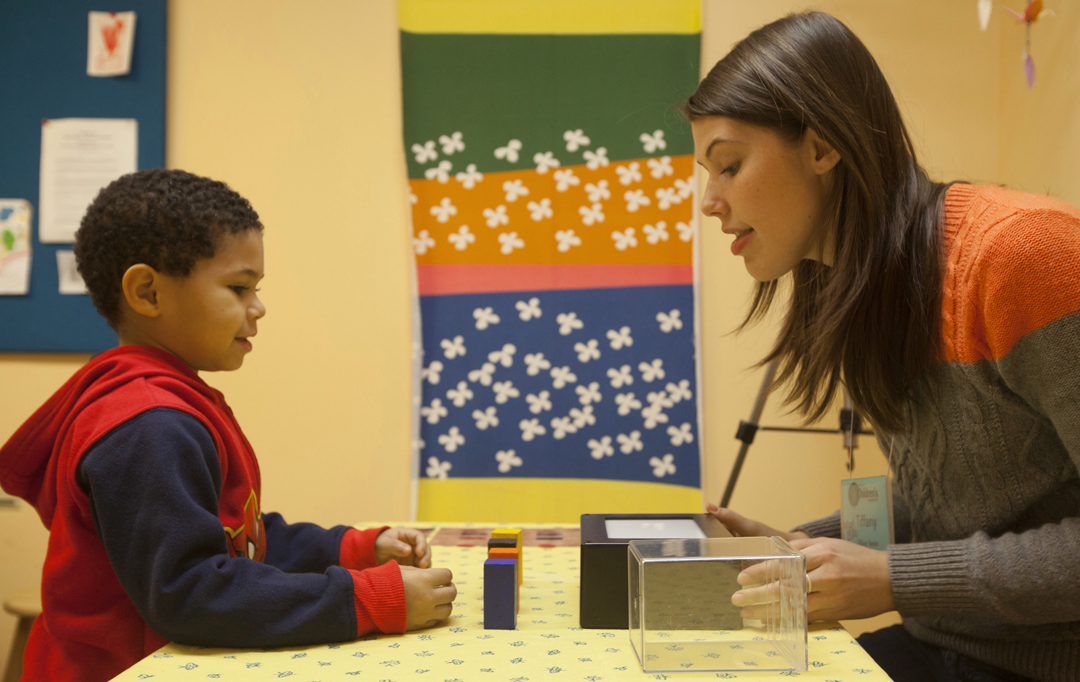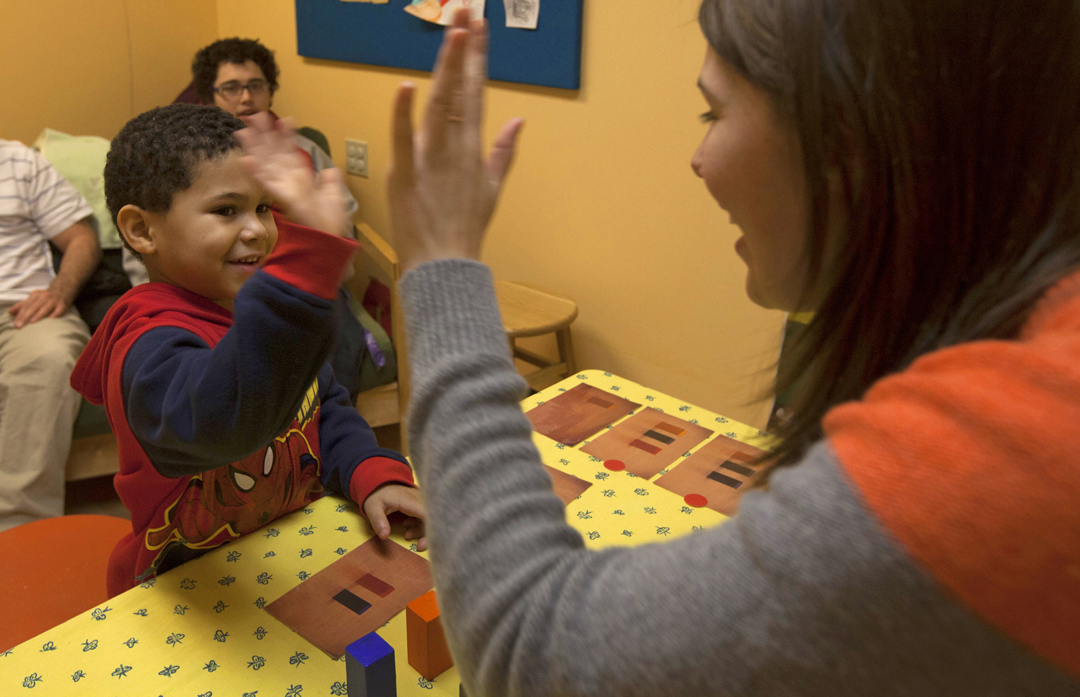PROVIDENCE, R.I. [Brown University] — Tens of thousands of New England kids come to the Providence Children’s Museum each year to learn, but more than a thousand of them also teach. Those are the kids who have come through the museum’s Mind Lab, where their playful participation in experiments led by Brown University’s David Sobel, professor of cognitive, linguistic, and psychological sciences, teaches researchers about learning.
In the chilly morning of Feb. 12, 5-year-old Dwayne Leonard of Providence played an experimental game with graduate student Tiffany Tassin as dad Sean Leonard looked on.

Tassin showed Dwayne a box and four colored blocks. When she placed all four blocks on the box, it lit up green and played “Take me out to the ballgame.” Dwayne smiled and announced, “Green!” Tassin produced a picture of the blocks with a green dot as a reminder. The yellow, black, and blue blocks in combination made it glow red. Tassin provided a picture reminder of that, too. Then yellow, black and orange made it glow red. The yellow block alone didn’t affect the box.
Dwayne saw some combinations but not all (he tried to suggest a few of his own). Then Tassin obscured the box and said she’d choose two blocks to put on the box. “No peeking,” she told Dwayne. The hidden box lit up green and played its music. Tassin asked Dwayne which two blocks he thought she used to make that happen. Asked to pick from three pictured possibilities, Dwayne chose blue and orange.
The experimental game invited Dwayne to do some diagnostic reasoning based on the evidence he had just observed. His answer was the one that reflected the most straightforward logical inference.

Dwayne was just demonstrating the game. Kids who participate in the research also talk beforehand to Andrea Wister a senior psychology concentrator. They describe what they think science is. Their answer and their subsequent response to the experiment provide data for Sobel and Tassin’s study of when and how scientific thinking develops in children.
The central question is whether children who demonstrate a more sophisticated sense of science in their interview also choose the answer to the box problem that correlates with the logical inference. That kind of knowledge can help guide early science education.
Sobel has worked with the museum for about a decade on such questions of childhood metacognition. In 2009 that partnership turned into the Mind Lab, a room on the first floor, right next to one of the museum’s educational play areas. The goal of the Brown, museum, and Providence College researchers who use the lab is to investigate how children learn and recognize that learning.
For the researchers, the Mind Lab provides a setting full of playful kids (and parents) who are there, as the museum slogan recommends, to “Come play, come learn!” Their research informs museum staff about what and how their little guests are thinking. That can be applied to how exhibits and experiences are conceived and designed, said Brown alumna Robin Meisner, the museum’s director of exhibits.
“For all of the work that we do around our exhibit development and our programs, we base it in research, we base it in educational theory,” Meisner said. “Dave is studying how these skills develop over the course of childhood and from the museum side we’re thinking about how what we’re doing on the museum floor is supporting that.”
It’s a continuum of research and practice. Museum project researcher Suzy Letourneau, embodies this. She splits her time between the museum (75 percent) and Sobel’s Brown lab (25 percent).
The science of science understanding
On Jan. 30, Sobel briefed an audience of Brown and museum leaders about his team’s recent results. With collaborators Deena Weisberg at the University of Pennsylvania and Kathy Hirsh-Pasek at Temple University he has learned that around age 7 kids make a key transition in how they describe and understand science.
“Before the age of 7 what we’ve found is that children basically answer this question by saying, ‘I don’t know’ or by generating content that is scientific,” Sobel said. “Science is dinosaurs or mixing things together. After age 7, not all children but a good enough minority will actually start generating much more sophisticated answers. They’ll start generating explanations of science that indicate it’s a process: Science is asking questions and finding out the answers. Science is doing experiments.”
And by 9 or 10 some children can generate mature explanations that rival those provided by undergraduates.
The box problem is inspired by a procedure developed at Columbia University. But those researchers have found that when they present a logically similar task that is steeped in the context of a specific science (e.g., Which combination of geological factors might lead to earthquakes?), 12-year-olds have great difficulty. Context and content may be getting in the way of reasoning in science education.
“One of the problems we have in science education is that there is a very deep focus on learning content to the detriment of learning some of the inferences involved.” Sobel said. “That’s why we use these decontextualized environments to assess science understanding.”
In future work, Sobel plans to compare children’s experience of the abstract box problem with a content-specific, scientifically contextualized version.
Learning how they learn
In the Mind Lab, Sobel and his students and museum partners also study learning in a more general way. They investigate questions such as when children come to understand how learning happens. Do young children understand that there is a learning process?
This, too, is done via a brief structured interview with kids at the museum.
“We ask children, ‘What do you think learning is?’ and ‘What does it mean to learn?’,” Sobel said. “We also ask them questions like, ‘Tell me something you’ve learned and tell me how you learned it’.”
“Four- and five-year olds really just don’t know how to respond this,” Sobel said. “If they can answer the questions at all it is in terms of a topic: ‘Learning is math’ or ‘Learning is learning to write.’ There is no real understanding of a process.”
But by the time children are 8 or 9 they can respond with better answers such as, “Learning is discovering something new” or “Learning is when you don’t know something and you find out the answer.”
At 6 or 7 years of age, Sobel said, kids are beginning to understand that learning is a mental process that requires things like paying attention, practicing and studying.
The projects dovetail with work Meisner and Letourneau do around the museum, in part to make the learning that occurs through play more apparent to kids and their parents.
“We want kids to be reflecting on what they are doing when they are playing and valuing what they are figuring out through the process of playing with things,” Letourneau said. “And we want caregivers to be noticing that kids are learning things when they are playing as well.”
After all, museum staff, University researchers, and parents all share a passion for encouraging kids to learn.
